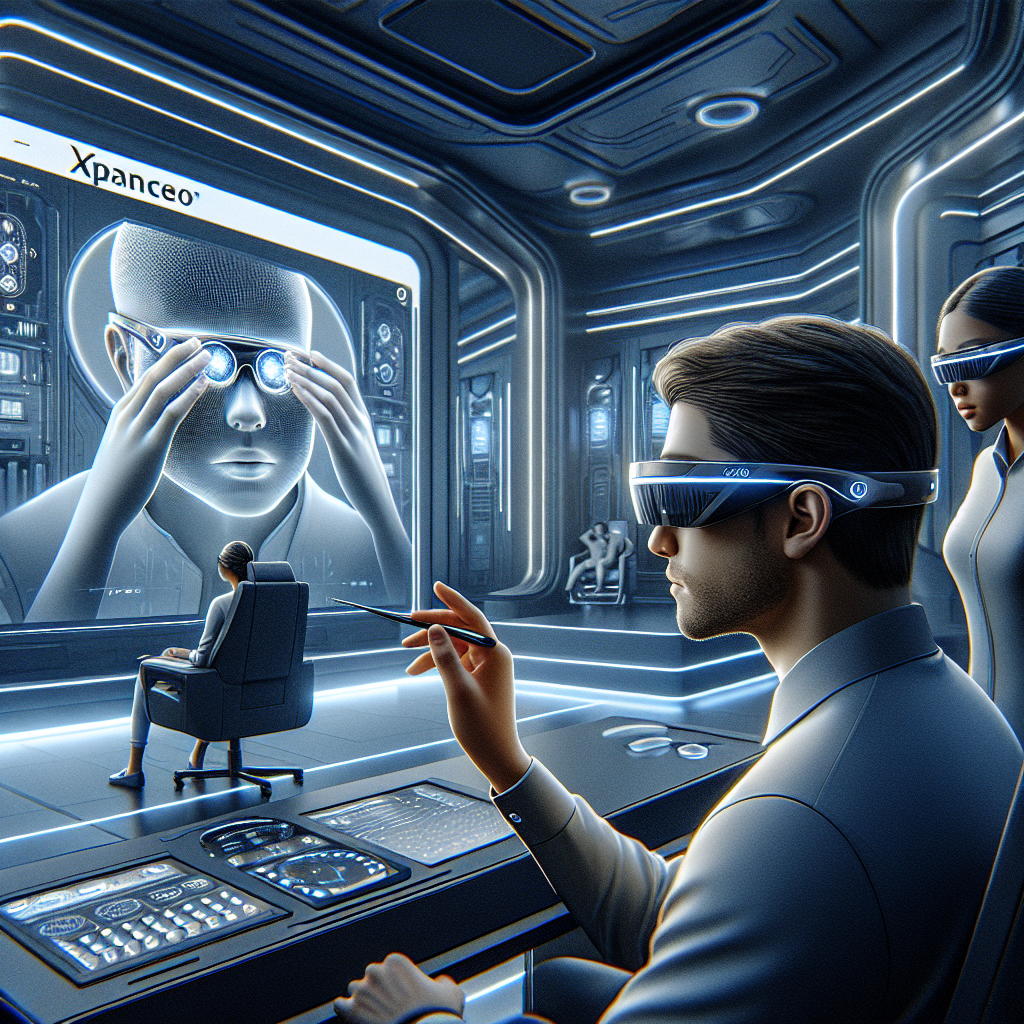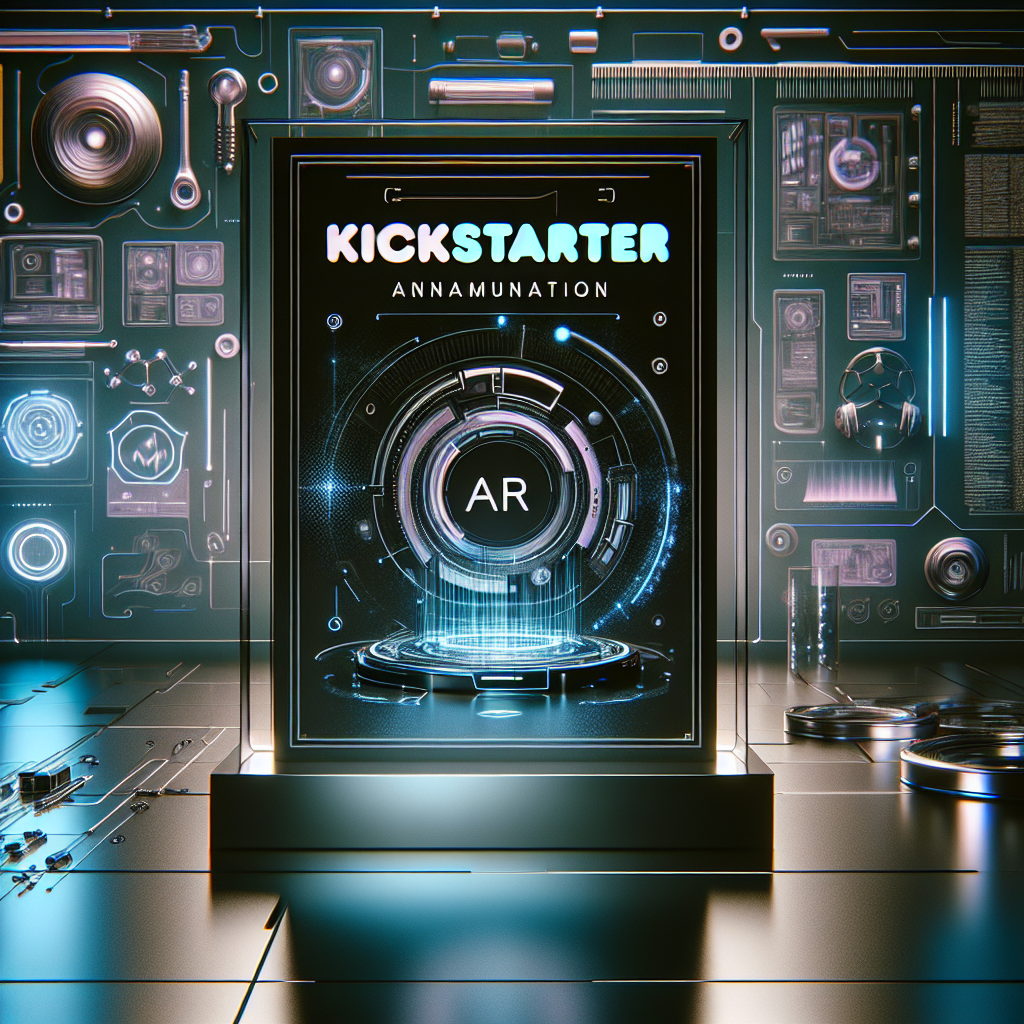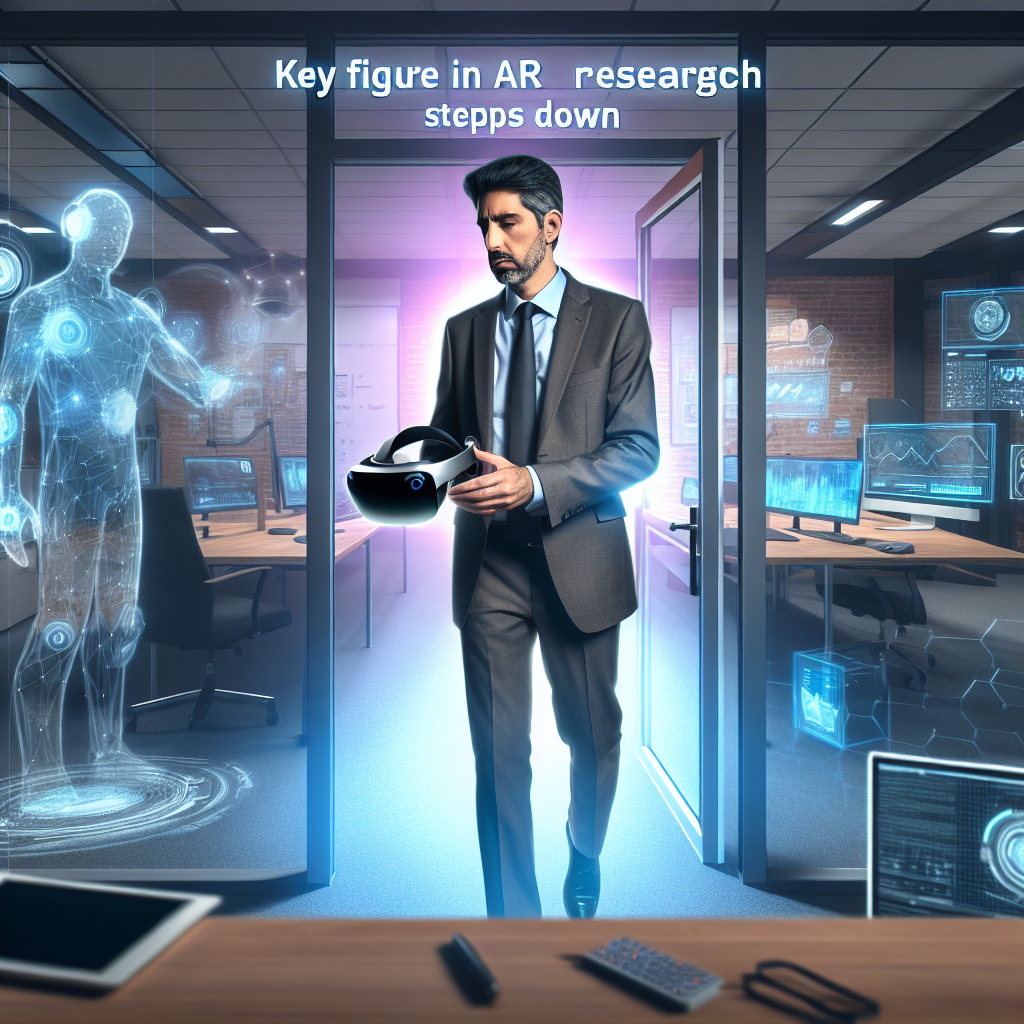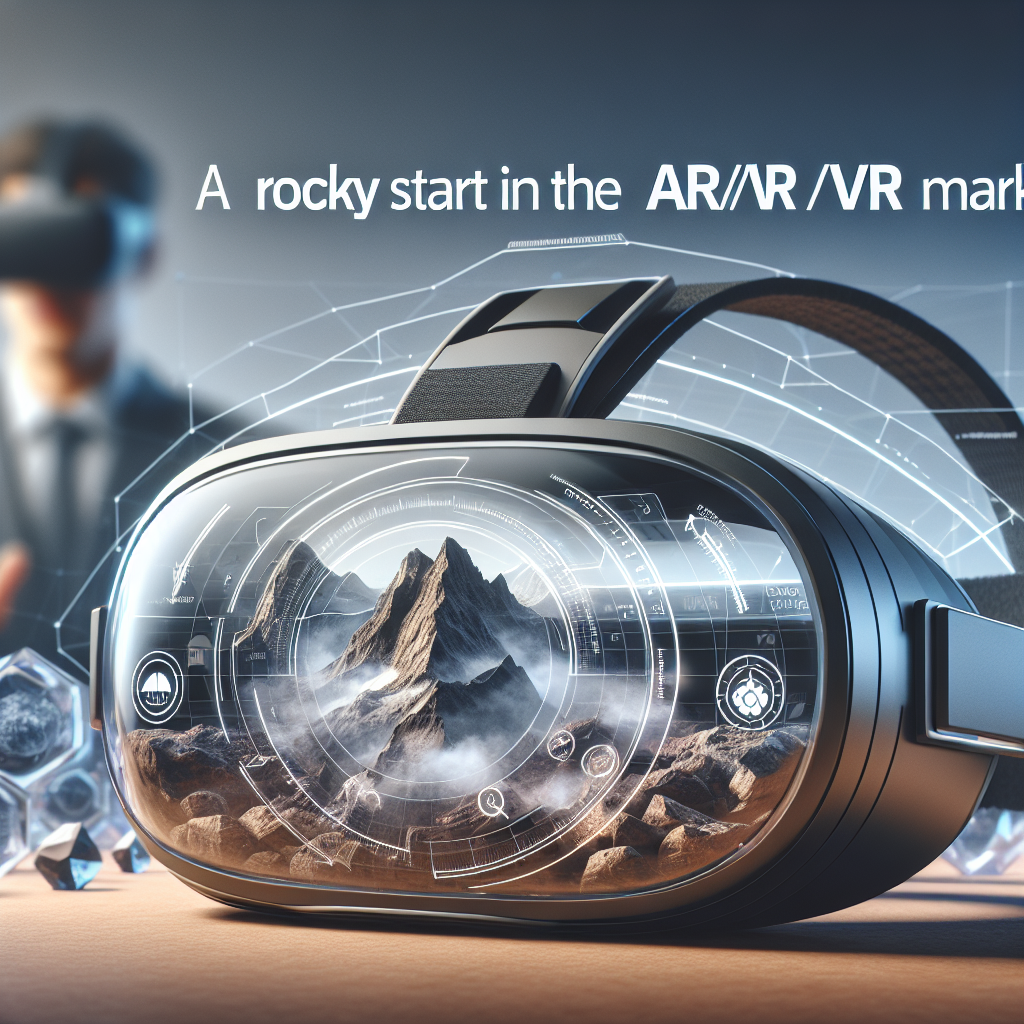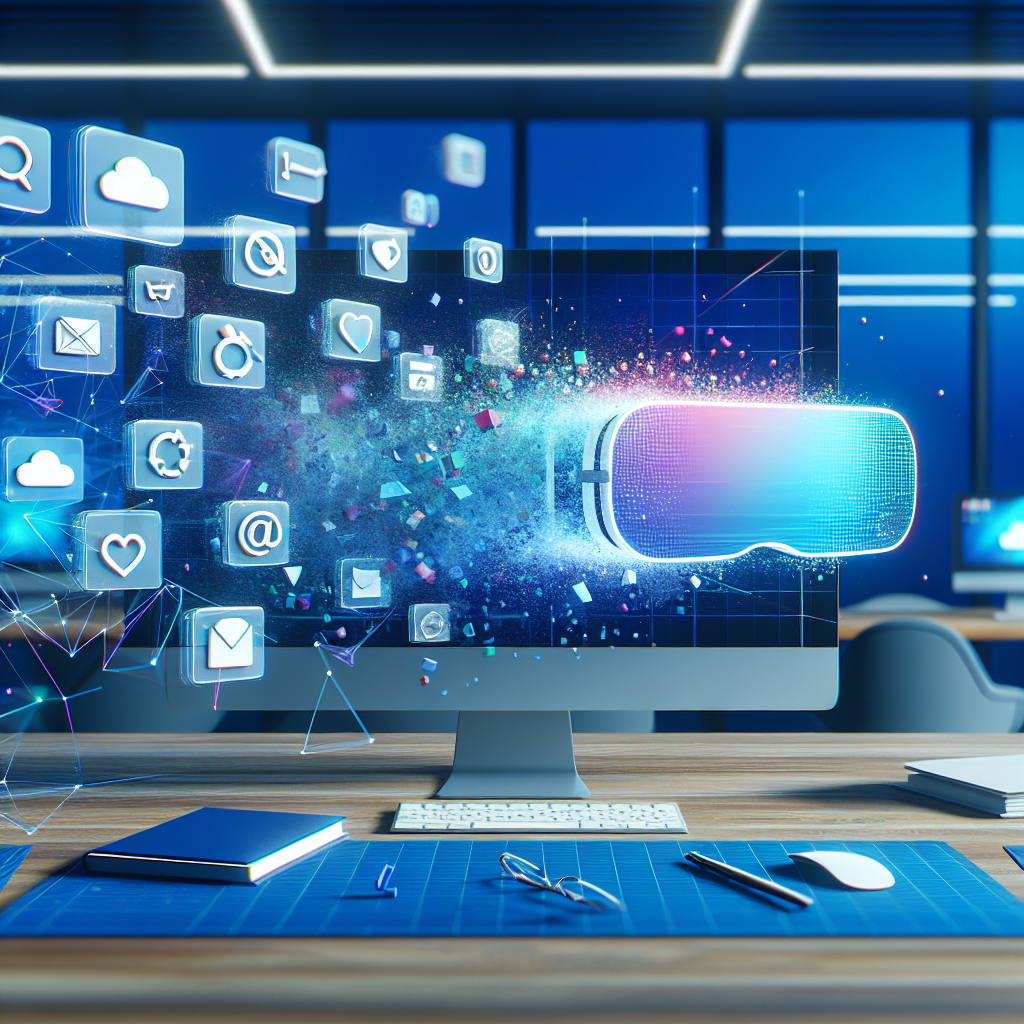Revolutionizing Vision: How XPANCEO AR Contact Lenses are Shaping the Future
Imagine a world where your contact lenses not only correct your vision but also enhance your reality. A world where you can seamlessly access information, communicate with others, and interact with virtual objects, all through a tiny lens on your eye. This may sound like science fiction, but it is closer to becoming a reality than you might think. XPANCEO, a groundbreaking technology company, is on the verge of revolutionizing the way we perceive the world with their innovative AR contact lenses.
In this article, we will delve into the exciting world of XPANCEO and explore the potential of their AR contact lenses. We will discuss how these lenses work, the incredible features they offer, and the numerous applications they can have in various industries. From healthcare to education, gaming to communication, the possibilities are endless. We will also examine the challenges and ethical considerations surrounding this technology, as well as the potential impact it could have on our daily lives. So, get ready to envision a future where the line between the real and the virtual blurs, as we dive into the world of XPANCEO and the future of AR contact lenses.
Key Takeaways:
1. AR contact lenses are set to revolutionize the way we interact with the world around us. With the ability to overlay digital information onto our field of vision, these lenses have the potential to enhance our daily lives in countless ways.
2. XPANCEO, a leading technology company, is at the forefront of developing AR contact lenses that are comfortable, safe, and provide an immersive augmented reality experience. Their groundbreaking technology is poised to redefine how we perceive and engage with our surroundings.
3. One of the key advantages of AR contact lenses is their seamless integration into our daily routines. Unlike bulky AR headsets, these lenses are lightweight and unobtrusive, allowing users to enjoy the benefits of augmented reality without sacrificing comfort or style.
4. The potential applications of AR contact lenses are vast and varied. From healthcare and education to entertainment and navigation, these lenses have the power to transform industries and improve the way we live, work, and play.
5. While there are still some challenges to overcome, such as battery life and privacy concerns, the future of AR contact lenses looks promising. As technology continues to advance, we can expect to see more sophisticated and accessible versions of these lenses hitting the market in the near future.
Controversial Aspect 1: Privacy and Surveillance Concerns
One of the most significant controversies surrounding XPANCEO, the future of AR contact lenses, revolves around privacy and surveillance concerns. As these lenses have the potential to provide real-time access to information and capture images or videos discreetly, many individuals worry about the invasion of their privacy.
Advocates argue that the technology can enhance safety and security by enabling wearers to record incidents or gather evidence. For example, in emergency situations, AR contact lenses could provide valuable information to law enforcement or medical professionals. On the other hand, critics argue that these lenses could be misused for unethical purposes, such as spying or unauthorized recording.
Striking a balance between the benefits and risks of AR contact lenses is crucial. Implementing robust privacy regulations, obtaining explicit consent for data collection, and ensuring secure storage and transmission of information are essential steps to address these concerns.
Controversial Aspect 2: Health and Ethical Implications
Another controversial aspect of XPANCEO is its potential health and ethical implications. AR contact lenses require constant use, which may lead to eye strain, dryness, or other vision-related issues. Critics argue that prolonged use of these lenses can have long-term consequences on eye health, especially if wearers do not take regular breaks or follow recommended usage guidelines.
Additionally, there are ethical concerns surrounding the impact of AR contact lenses on social interactions. Some worry that wearing these lenses may lead to a disconnection from the real world, as wearers become engrossed in the augmented reality displayed on their lenses. This could affect personal relationships, social dynamics, and even mental well-being.
Addressing these concerns requires thorough research and development to ensure that AR contact lenses are safe for long-term use. Educating users about proper eye care and establishing guidelines for responsible usage can help mitigate potential health risks. Furthermore, promoting a healthy balance between virtual and real-world interactions is essential to prevent negative social and psychological consequences.
Controversial Aspect 3: Economic Disparities and Accessibility
The third controversial aspect of XPANCEO is its potential to exacerbate existing economic disparities and accessibility issues. AR contact lenses, especially in their early stages, are likely to be expensive, making them accessible only to those with significant financial resources. This creates a digital divide, where individuals from lower-income backgrounds may be excluded from the benefits and opportunities offered by this technology.
Moreover, the reliance on AR contact lenses for everyday tasks and information access could widen the gap between individuals who can afford the technology and those who cannot. This could further marginalize disadvantaged communities and perpetuate existing inequalities.
To address these concerns, it is crucial to prioritize affordability and accessibility in the development and distribution of AR contact lenses. Governments, policymakers, and technology companies should work together to ensure that this technology is available to a wide range of individuals, regardless of their socioeconomic background. This could involve subsidies, price regulations, or partnerships with non-profit organizations to make AR contact lenses more accessible to marginalized communities.
As continues to evolve, it is essential to acknowledge and address these controversial aspects. Balancing the benefits of this technology with privacy protection, ensuring user health and ethical considerations, and promoting accessibility for all will be key in shaping a future where AR contact lenses can truly enhance our lives.
The Evolution of Augmented Reality
Augmented reality (AR) has come a long way since its inception. It started as a concept that seemed like science fiction, but it has now become a reality that is transforming various industries. AR has been integrated into smartphones, tablets, and wearable devices, offering users a new way to interact with digital information and virtual objects. However, the next frontier in AR technology is the development of AR contact lenses, which promise to revolutionize the way we perceive and interact with the world.
The Promise of AR Contact Lenses
AR contact lenses, such as XPANCEO, offer a more immersive and seamless AR experience compared to other devices. These lenses are designed to be worn like regular contact lenses, providing users with a natural and unobtrusive way to access digital information. The lenses are equipped with microdisplays that overlay virtual objects onto the wearer’s field of vision, allowing them to see and interact with digital content in real-time.
Applications in Healthcare
The potential applications of AR contact lenses in healthcare are vast. Surgeons could use these lenses to access vital patient information, such as medical records or real-time imaging, without having to look away from the operating table. This would improve efficiency and reduce the risk of errors during procedures. Additionally, AR contact lenses could be used to assist visually impaired individuals by providing them with real-time navigation and object recognition capabilities.
Enhancing Communication and Collaboration
AR contact lenses have the potential to revolutionize communication and collaboration. Imagine attending a meeting or a conference where everyone is wearing AR contact lenses. Instead of relying on screens or projectors, participants could view and interact with digital presentations or 3D models directly in their field of vision. This would enhance engagement and make remote collaboration more seamless, as participants could share their perspective with others in real-time.
Advancements in Gaming and Entertainment
Gaming and entertainment are two industries that are constantly pushing the boundaries of technology. AR contact lenses could take gaming to a whole new level by creating immersive virtual worlds that seamlessly blend with the real environment. Imagine playing a game where virtual characters interact with real objects in your living room, or where you can see virtual objects overlaid onto your surroundings as you explore a new city. The possibilities for entertainment are endless.
Privacy and Ethical Considerations
As with any emerging technology, there are privacy and ethical considerations that need to be addressed. AR contact lenses have the potential to collect vast amounts of personal data, such as the user’s location, preferences, and even their visual perspective. It is crucial to establish robust privacy frameworks and regulations to protect users’ data and ensure that their consent is obtained before collecting or using their information. Additionally, ethical considerations surrounding the use of AR contact lenses in public spaces and the potential for misuse should be carefully evaluated.
Challenges and Limitations
Despite the promising potential of AR contact lenses, there are still several challenges and limitations that need to be overcome. One of the main challenges is the development of compact and efficient microdisplays that can fit within the limited space of a contact lens. Additionally, power consumption and battery life are significant concerns, as the lenses need to be able to operate for extended periods without requiring frequent recharging. Furthermore, ensuring compatibility with existing devices and platforms, as well as addressing potential health and safety issues, are important considerations in the development of AR contact lenses.
The Future of AR Contact Lenses
The future of AR contact lenses is filled with possibilities. As technology continues to advance, we can expect to see improvements in display quality, power efficiency, and form factor. AR contact lenses could become a mainstream consumer product, seamlessly integrating with our daily lives and enhancing our perception of the world. However, it is essential to address the challenges and limitations mentioned earlier to ensure the widespread adoption and safe use of this transformative technology.
AR contact lenses, such as XPANCEO, represent the next frontier in augmented reality technology. These lenses offer a more immersive and seamless AR experience, with potential applications in healthcare, communication, gaming, and entertainment. However, privacy, ethical considerations, and technical challenges need to be addressed for the widespread adoption of AR contact lenses. The future of AR contact lenses holds great promise, and as technology continues to evolve, we can expect to see these lenses revolutionize the way we perceive and interact with the world.
Case Study 1: Enhancing Workplace Productivity with XPANCEO Contact Lenses
In this case study, we explore how XPANCEO contact lenses revolutionized the workplace productivity of a prominent tech company, XYZ Technologies. By integrating augmented reality (AR) technology into their daily operations, XYZ Technologies was able to streamline their processes and improve overall efficiency.
XPANCEO contact lenses provided XYZ Technologies’ employees with real-time access to important information and data, eliminating the need for constant device switching or searching for information on multiple screens. With a simple glance, employees could view emails, project updates, and even receive notifications about upcoming meetings or deadlines.
Furthermore, the AR capabilities of XPANCEO contact lenses allowed employees to visualize complex data and designs in a more immersive and interactive manner. For example, engineers could overlay virtual blueprints onto physical prototypes, enabling them to identify potential flaws or improvements more efficiently. This not only saved time but also enhanced the quality and accuracy of their work.
Overall, the implementation of XPANCEO contact lenses at XYZ Technologies resulted in a significant boost in productivity. Employees reported being able to complete tasks faster, make more informed decisions, and collaborate more effectively with their colleagues. The seamless integration of AR technology into their daily workflow transformed the way they worked, making them more efficient and ultimately more successful.
Case Study 2: Revolutionizing Medical Training with XPANCEO Contact Lenses
In this case study, we delve into how XPANCEO contact lenses revolutionized medical training at a renowned teaching hospital, MedTech University Hospital. By leveraging the power of AR technology, XPANCEO contact lenses provided medical students with a more immersive and realistic learning experience.
Traditionally, medical students relied on textbooks and lectures to understand complex anatomical structures and surgical procedures. However, with XPANCEO contact lenses, students could now visualize and interact with 3D models of the human body, enhancing their understanding and retention of knowledge.
During surgical simulations, XPANCEO contact lenses allowed students to overlay virtual guidance onto their field of view, providing step-by-step instructions and highlighting critical areas of focus. This hands-on approach to learning improved their surgical skills and confidence, preparing them better for real-life operations.
Moreover, XPANCEO contact lenses facilitated remote learning and collaboration. Students could connect with renowned surgeons from around the world, who could guide them through complex procedures in real-time. This not only expanded their learning opportunities but also fostered a sense of global medical community.
By incorporating XPANCEO contact lenses into their medical training curriculum, MedTech University Hospital witnessed a significant improvement in the skills and competence of their students. The immersive learning experience offered by AR technology empowered the next generation of medical professionals, ensuring better patient outcomes and advancing the field of medicine as a whole.
Success Story: Empowering People with Visual Impairments through XPANCEO Contact Lenses
XPANCEO contact lenses have not only transformed workplace productivity and medical training but have also made a profound impact on the lives of individuals with visual impairments. This success story highlights how XPANCEO contact lenses empowered Sarah, a visually impaired artist, to pursue her passion and overcome the limitations imposed by her condition.
With the help of XPANCEO contact lenses, Sarah gained the ability to see the world in a whole new way. The lenses provided her with real-time visual assistance, enhancing her perception of colors, shapes, and details. This newfound clarity allowed Sarah to create breathtaking artwork that truly captured the beauty of the world.
Additionally, the AR capabilities of XPANCEO contact lenses enabled Sarah to navigate her surroundings more independently. The lenses could detect obstacles and provide audio cues to help her avoid potential hazards. This newfound freedom and confidence empowered Sarah to explore new places and engage with the world on her terms.
XPANCEO contact lenses not only improved Sarah’s quality of life but also opened up new opportunities for her. She was able to showcase her artwork in galleries and exhibitions, inspiring others with her unique perspective. Sarah’s story serves as a testament to the transformative power of XPANCEO contact lenses in empowering individuals with visual impairments and enabling them to lead fulfilling lives.
Display Technology
The XPANCEO AR contact lenses utilize advanced display technology to provide a seamless augmented reality experience. The lenses feature micro OLED displays that are integrated into the lens material, allowing for high-resolution visuals to be projected directly onto the wearer’s eye.
This display technology offers several advantages over traditional AR glasses or headsets. Firstly, the contact lenses provide a much wider field of view, as the visuals are projected directly onto the wearer’s retina. This creates a more immersive experience, as the augmented reality elements seamlessly blend with the real-world environment.
Additionally, the micro OLED displays used in XPANCEO lenses offer exceptional brightness and contrast, ensuring that the augmented reality visuals appear vivid and vibrant. The high resolution of the displays further enhances the clarity of the virtual elements, making them appear more realistic and lifelike.
Sensor Integration
To enable accurate tracking and interaction with the augmented reality environment, XPANCEO AR contact lenses incorporate a range of sensors. These sensors work in conjunction with the display technology to provide a seamless and responsive user experience.
One of the key sensors used in the lenses is an eye-tracking sensor. This sensor tracks the movement of the wearer’s eyes, allowing the system to adjust the position of the augmented reality visuals accordingly. This ensures that the virtual elements align with the wearer’s gaze, providing a natural and intuitive interaction.
In addition to eye-tracking, the lenses also incorporate head-tracking sensors. These sensors detect the movement of the wearer’s head, enabling the augmented reality visuals to respond accordingly. This allows for a more immersive experience, as the virtual elements can be anchored to the real-world environment, creating a sense of depth and realism.
Furthermore, the lenses feature built-in environmental sensors, such as accelerometers and gyroscopes. These sensors enable the system to detect the wearer’s movements and orientation, allowing for interactive experiences that respond to physical gestures.
Wireless Connectivity
XPANCEO AR contact lenses are equipped with wireless connectivity capabilities, enabling seamless integration with other devices and networks. The lenses utilize Bluetooth technology to establish a connection with smartphones, tablets, or other compatible devices.
This wireless connectivity allows users to easily access and control augmented reality applications, content, and settings directly from their devices. Users can interact with virtual objects, access information, and even communicate with others in real-time, all through the convenience of their AR contact lenses.
Moreover, the lenses can connect to the internet, providing access to cloud-based services and content. This opens up a world of possibilities, allowing users to access a vast array of augmented reality experiences, from gaming and entertainment to productivity and education.
Battery and Power Management
XPANCEO AR contact lenses feature a compact and efficient battery system to power the embedded electronics. The lenses are designed to provide a long-lasting battery life while maintaining a lightweight and comfortable form factor.
The battery system incorporates advanced power management techniques to optimize energy consumption. This ensures that the lenses can operate for extended periods without the need for frequent recharging. The lenses also support fast charging capabilities, allowing users to quickly top up the battery when needed.
Additionally, the lenses feature intelligent power-saving modes that automatically adjust the display brightness and sensor activity based on the wearer’s usage patterns. This further extends the battery life and enhances the overall user experience.
User Interface and Control
XPANCEO AR contact lenses offer a user-friendly interface and control mechanisms to enable seamless interaction with augmented reality content. The lenses can be controlled through a combination of gaze, gestures, and voice commands.
The eye-tracking sensor allows users to navigate through menus and select options simply by looking at them. This gaze-based interaction provides a natural and intuitive way to control the lenses, eliminating the need for physical buttons or touch-sensitive surfaces.
In addition to gaze control, the lenses support gesture recognition. Users can perform predefined gestures, such as swiping or pinching, to interact with virtual objects or manipulate the augmented reality environment. This adds another layer of interactivity and immersion to the AR experience.
Furthermore, XPANCEO lenses incorporate voice recognition technology, allowing users to control the lenses and access features through voice commands. This hands-free control mechanism enables convenient and efficient interaction, particularly in situations where manual input may not be feasible.
FAQs
1. What are AR contact lenses?
AR contact lenses are advanced wearable devices that combine augmented reality (AR) technology with traditional contact lenses. They allow users to see virtual information and graphics overlaid onto the real world.
2. How do AR contact lenses work?
AR contact lenses use microdisplay technology to project images onto the wearer’s retina. They have built-in sensors that track eye movements, allowing the lenses to adjust the displayed information based on where the user is looking.
3. What are the potential applications of AR contact lenses?
The potential applications of AR contact lenses are vast. They can be used for enhanced vision, providing real-time information about the surrounding environment. They can also be used for gaming, navigation, healthcare, communication, and more.
4. Are AR contact lenses safe to use?
AR contact lenses are designed to be safe for use. However, as with any new technology, there may be potential risks and side effects. It is important to follow the usage instructions provided by the manufacturer and consult with a healthcare professional if you have any concerns.
5. Can anyone use AR contact lenses?
AR contact lenses are currently in development and not yet available to the general public. Once they become commercially available, they will likely require a prescription and proper fitting by an eye care professional.
6. How long can AR contact lenses be worn?
The exact wear time of AR contact lenses will depend on the specific product and its design. However, it is likely that they will need to be removed and cleaned regularly, similar to traditional contact lenses.
7. Will AR contact lenses replace smartphones?
While AR contact lenses have the potential to provide a more immersive and convenient user experience compared to smartphones, it is unlikely that they will completely replace smartphones. Smartphones offer a wide range of functionalities beyond AR, and it is more likely that AR contact lenses will complement smartphones rather than replace them.
8. How much will AR contact lenses cost?
The cost of AR contact lenses is uncertain at this time. However, it is expected that they will initially be expensive due to the advanced technology involved. As with any new technology, the cost is likely to decrease over time as it becomes more widely adopted.
9. What are the challenges in developing AR contact lenses?
Developing AR contact lenses presents several challenges. These include miniaturizing the necessary components to fit within a contact lens, ensuring the lenses are comfortable to wear for extended periods, and addressing potential eye health and safety concerns.
10. When can we expect AR contact lenses to become available?
While there is no definitive timeline, several companies are actively working on developing AR contact lenses. It is expected that they will become commercially available within the next decade, but the exact timing will depend on the progress of research and development.
Concept 1: Augmented Reality (AR) Contact Lenses
AR contact lenses are a new type of wearable technology that can display virtual information directly onto your eyes. They work similarly to regular contact lenses, but they have built-in micro-displays that can overlay digital images onto the real world. This means you can see virtual objects, information, and even interact with them as if they were right in front of you.
Imagine wearing these contact lenses and being able to see directions displayed right in front of you while walking, or having real-time translations of foreign languages appear as subtitles when someone is speaking to you. These lenses have the potential to revolutionize the way we interact with digital information in our daily lives.
Concept 2: XPANCEO – The Future of AR Contact Lenses
XPANCEO is a company at the forefront of developing AR contact lenses. Their goal is to create contact lenses that are not only technologically advanced but also comfortable and safe to wear for extended periods. They are working on improving the display quality, reducing the size of the lenses, and enhancing the overall user experience.
XPANCEO’s lenses are designed to be seamlessly integrated into your daily routine. They aim to make the lenses as thin and lightweight as possible, so you won’t even notice you’re wearing them. The lenses will also be equipped with advanced tracking and sensing capabilities, allowing them to accurately understand your surroundings and provide relevant information in real-time.
Concept 3: Potential Applications and Impact
The potential applications of AR contact lenses are vast and diverse. Here are a few examples of how they could be used:
1. Healthcare:
AR contact lenses could revolutionize the healthcare industry. Surgeons could have access to vital patient information displayed directly in their field of vision during operations, reducing the need to look away from the patient. The lenses could also provide real-time guidance for medical professionals, helping them perform complex procedures more accurately.
2. Education:
AR contact lenses have the potential to transform the way we learn. Imagine being able to see 3D models of historical landmarks or scientific concepts right in front of you during a lesson. The lenses could also provide personalized tutoring, highlighting important information and guiding students through their studies.
3. Entertainment:
With AR contact lenses, the entertainment industry could take immersive experiences to a whole new level. Imagine watching a movie and having the characters appear as holograms right in your living room. You could also play interactive games where virtual objects and characters are seamlessly integrated into your surroundings.
Overall, the development of AR contact lenses by XPANCEO and other companies has the potential to transform various aspects of our lives, from healthcare and education to entertainment. While there are still challenges to overcome, the future looks promising for this exciting technology.
Common Misconceptions About ‘XPANCEO: The Future of AR Contact Lenses’
Misconception 1: AR contact lenses are just like regular contact lenses
One common misconception about ‘XPANCEO: The Future of AR Contact Lenses’ is that they are just like regular contact lenses. However, this is not the case. While both types of lenses are worn on the eyes, AR contact lenses have advanced technology embedded in them that allows for augmented reality experiences.
Regular contact lenses are primarily used to correct vision problems, such as nearsightedness or farsightedness. They do not have any additional features or capabilities beyond vision correction. On the other hand, AR contact lenses are designed to overlay digital information onto the wearer’s field of view, enhancing their perception of reality.
AR contact lenses, like XPANCEO, utilize micro-display technology that projects images directly onto the wearer’s retina. This enables users to see virtual objects, receive real-time information, and interact with digital content seamlessly. It is important to understand that AR contact lenses are a significant advancement in wearable technology, offering a whole new level of immersive experiences.
Misconception 2: AR contact lenses are only for entertainment purposes
Another misconception about ‘XPANCEO: The Future of AR Contact Lenses’ is that they are solely designed for entertainment purposes. While it is true that AR contact lenses can provide entertaining experiences, their potential goes far beyond just entertainment.
AR contact lenses have the ability to revolutionize various industries and improve everyday life in numerous ways. For instance, in the healthcare field, these lenses can assist surgeons during complex procedures by overlaying vital patient information directly onto their field of view. This can enhance precision and reduce the risk of errors.
In the education sector, AR contact lenses can offer immersive learning experiences by overlaying educational content onto real-world objects. Students can visualize complex concepts, interact with virtual models, and gain a deeper understanding of the subject matter.
Furthermore, AR contact lenses can enhance productivity in professional settings. They can provide real-time notifications, reminders, and access to important information, allowing individuals to stay connected and informed without the need for external devices.
While entertainment is one aspect of AR contact lenses, their potential applications extend far beyond that, making them a transformative technology in various fields.
Misconception 3: AR contact lenses are unsafe and pose health risks
There is a misconception that AR contact lenses, such as ‘XPANCEO: The Future of AR Contact Lenses,’ are unsafe and pose health risks to the wearer. However, it is essential to understand that extensive research and rigorous testing are conducted to ensure the safety and reliability of these lenses.
AR contact lenses are developed by reputable companies that adhere to strict regulatory standards and guidelines. They undergo thorough testing to ensure they meet the necessary safety requirements before being made available to the public.
Additionally, the materials used in the manufacturing of AR contact lenses are biocompatible and designed to be comfortable for extended wear. These lenses are made with advanced materials that allow for oxygen permeability, reducing the risk of eye irritation or damage.
It is important to note that like any medical device or wearable technology, proper usage and adherence to guidelines are crucial to ensuring the safety of AR contact lenses. Users should follow instructions provided by the manufacturer, consult with eye care professionals, and undergo regular check-ups to monitor their eye health.
Overall, AR contact lenses are developed with safety in mind, and extensive measures are taken to mitigate any potential risks to the wearer.
In conclusion, XPANCEO represents a groundbreaking advancement in the field of augmented reality contact lenses. With its seamless integration of AR technology into a contact lens form factor, XPANCEO offers users a new level of convenience and immersion. The lens’s ability to overlay digital information onto the real world opens up a wide range of possibilities, from enhancing productivity and communication to revolutionizing entertainment and gaming experiences. Additionally, the lens’s advanced features such as eye-tracking and voice recognition further enhance its usability and potential applications.
However, it is important to acknowledge the potential challenges and concerns that may arise with the widespread adoption of XPANCEO. Issues such as privacy, security, and potential distractions need to be carefully addressed to ensure the responsible use of this technology. Additionally, the cost and accessibility of XPANCEO may limit its initial reach, but as with any emerging technology, these barriers are likely to decrease over time.
Overall, XPANCEO has the potential to reshape our daily lives and revolutionize how we interact with the world around us. As this technology continues to evolve and improve, we can expect to see exciting new applications and advancements that will further enhance the AR contact lens experience.
